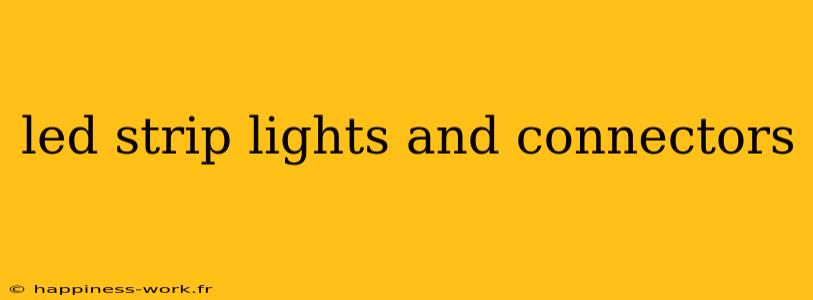LED strip lights have become increasingly popular for both residential and commercial use due to their versatility, energy efficiency, and ease of installation. They can transform a space, provide ambient lighting, and even add a touch of color to your decor. In this article, we will explore what LED strip lights are, the different types of connectors available, and how to effectively use them for your projects.
What Are LED Strip Lights?
LED strip lights, also known as LED tape lights, are flexible circuit boards populated with LED lights. They are available in various colors and brightness levels and can be cut to fit specific lengths. This adaptability makes LED strip lights perfect for a multitude of applications, including under-cabinet lighting, accent walls, or even decorative lighting for special events.
Key Benefits of LED Strip Lights
- Energy Efficiency: LED strip lights consume less electricity compared to traditional lighting options, which can lead to reduced energy bills.
- Longevity: With a lifespan of up to 50,000 hours, they offer long-term use with minimal maintenance.
- Customization: They can be cut, dimmed, and programmed for various effects, allowing for endless possibilities in design and function.
Types of Connectors for LED Strip Lights
When setting up LED strip lights, connectors are essential for joining multiple strips or connecting them to a power source. Here are some of the most common types of connectors:
1. Solderless Connectors
These connectors allow you to link LED strips without the need for soldering. They are easy to use and often come in two-pole or four-pole options depending on whether you are connecting single-color or RGB strips.
Practical Example: If you have a 5-meter length of RGB strip lights and want to connect two sections together, you can use a solderless connector to achieve a seamless transition.
2. Soldered Connections
For those who are comfortable with soldering, soldered connections offer a more permanent solution. This method provides a reliable connection and is ideal for complex installations or where a strong bond is necessary.
Analysis: While soldered connections are more robust, they do require some skill and tools, making them less accessible for DIYers. If you’re not confident in your soldering abilities, it's best to stick with solderless options.
3. Extension Cables
Extension cables are used to extend the distance between your LED strips and the power source or between two strips. They come in various lengths and are particularly useful when your power source is located far from the installation site.
4. Power Connectors
These connectors ensure your LED strips receive adequate power. They come in different types, depending on the voltage of your strips (such as 12V or 24V), and can include terminal blocks for easier connections.
How to Choose the Right Connector
When selecting connectors for your LED strip lights, consider the following factors:
- Compatibility: Ensure the connectors match the type of LED strip lights you are using. For example, RGB strips require different connectors than single-color strips.
- Application: Think about the intended use. For temporary installations, solderless connectors may suffice, while permanent setups could benefit from soldered connections.
- Ease of Use: If you are a beginner, opt for user-friendly options that require minimal tools and skills.
Installation Tips
-
Plan Your Layout: Before starting your installation, sketch out where the lights will go and how many connectors you will need. This can save time and reduce waste.
-
Measure Twice, Cut Once: When cutting LED strips, always measure carefully and ensure you cut at designated points to avoid damaging the strips.
-
Test Connections: Before finalizing your installation, test each segment to ensure all connectors and connections work correctly.
-
Use Adhesive Backing: Most LED strips come with adhesive backing, making it easy to stick them to various surfaces. However, for added security, consider using mounting clips.
Conclusion
LED strip lights and their connectors provide a unique opportunity to enhance your living or workspace with custom lighting solutions. By understanding the different types of connectors available and how to effectively use them, you can create an environment that suits your style and needs. Whether you are a DIY enthusiast or just starting out, the flexibility of LED strip lights can cater to any lighting project.
Additional Resources
For more comprehensive information, you can refer to guides on websites like WikiHow that provide insights into connecting LED strips and troubleshooting common issues.
Key Takeaways
- LED strip lights are versatile, energy-efficient, and easy to install.
- Various connectors are available depending on the requirements of your project.
- Proper planning and installation techniques can enhance the effectiveness of your lighting design.
By following this guide, you will not only understand how to select and use LED strip lights and connectors effectively but also feel confident in tackling your own lighting projects.
This article builds on existing information from WikiHow while offering unique insights and practical advice, ensuring relevance and adding value to readers interested in LED strip lights and connectors.
